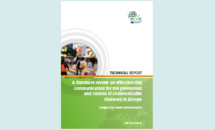A literature review on effective risk communication for the prevention and control of communicable diseases in Europe
This review brings together the current body of literature on risk communication (focused on communicable diseases) in a concise reference document which can be used to inform the development of evidence-based risk communication strategies and approaches. The review demonstrates that there is an impressive body of literature on risk communication relevant to the prevention and control of communicable diseases. This literature is complicated, however, by blurred definitions and overlap between risk communication and crisis communication. It is also widely dispersed across academic disciplines, lacking rigorous empirical evidence to demonstrate effectiveness, challenged by the complex and unpredictable ways that individuals perceive risk and the environmental, social, cultural and linguistic factors through which risk communication is viewed.
Executive Summary
Risk communication is seen as one of the essential ways of limiting morbidity and mortality, as well as the damage to national economies and public health infrastructure caused by communicable diseases.
This review highlights the particular challenges faced by a multi-cultural and multi-lingual Europe when designing effective risk communication strategies. National and international collaboration is identified as being vital to deal with these challenges as well as further development of cross-sectoral risk preparedness strategies. Although there are many resources available to risk communicators today, limitations have been exposed once they have been tested. Gaps which the report identified include risk communication messages often failing to reach the intended targets and a lack of resources to meet the new and changing needs of more web-based societies.
Download








